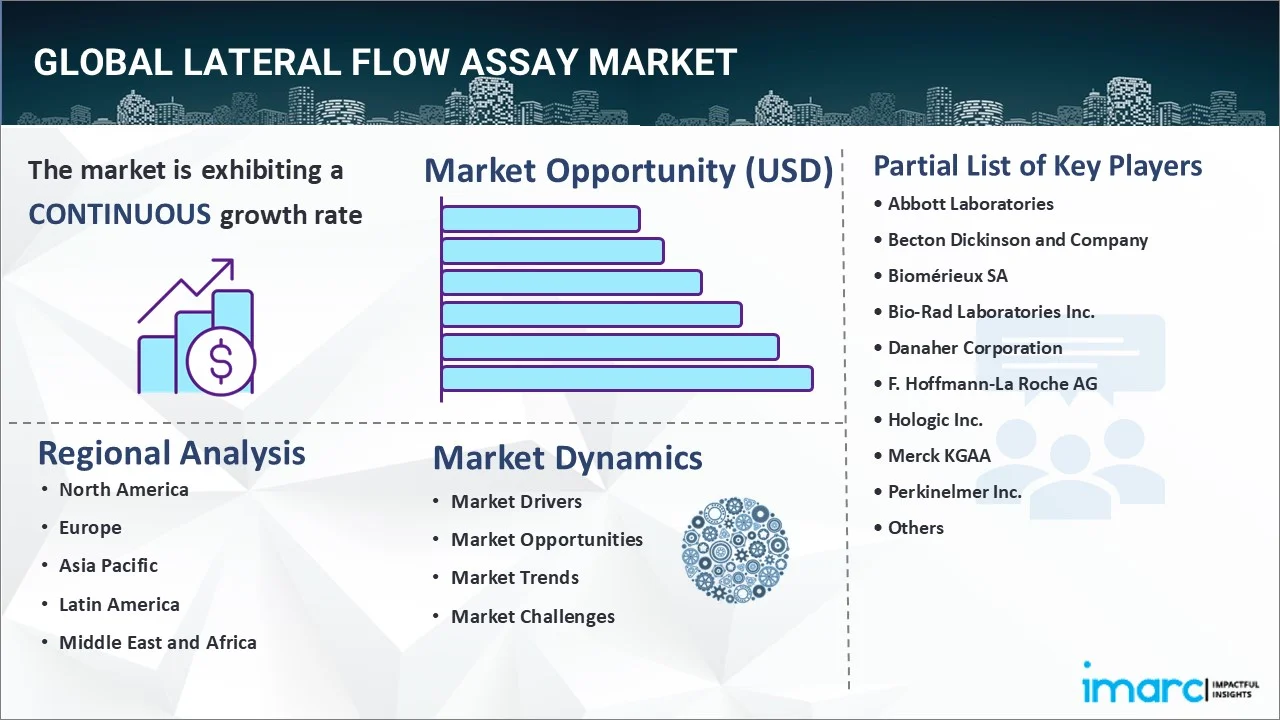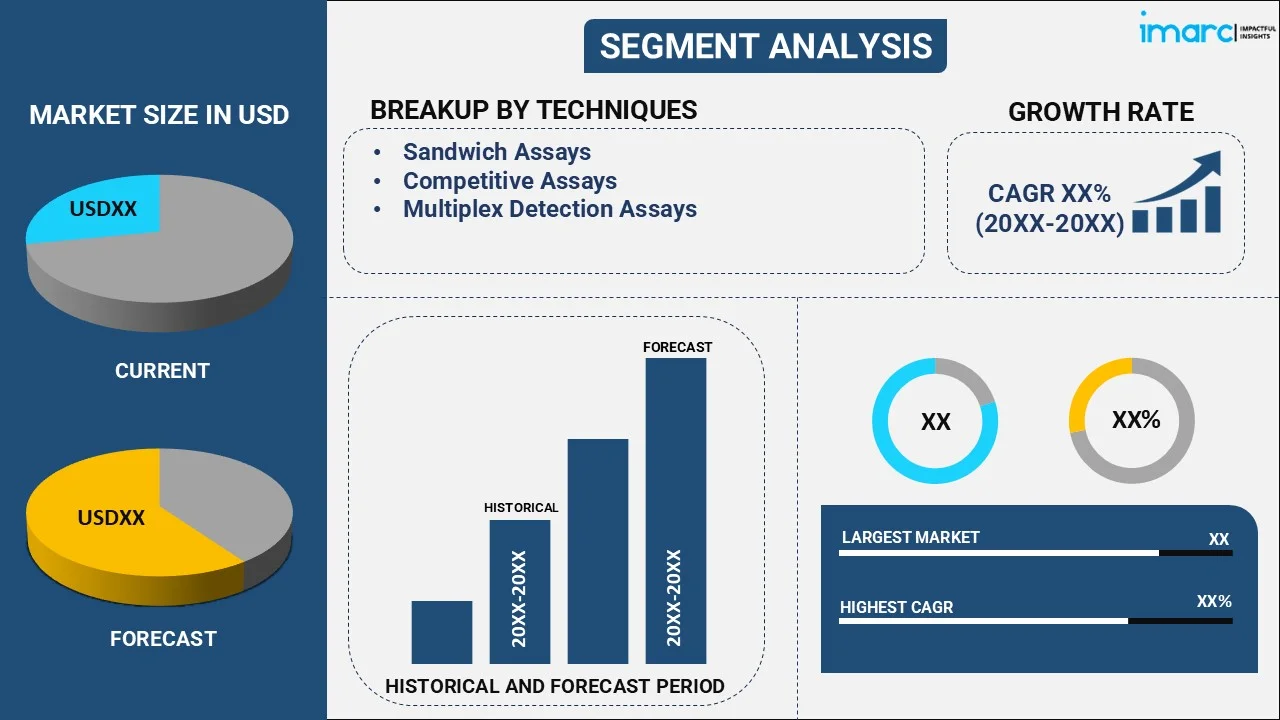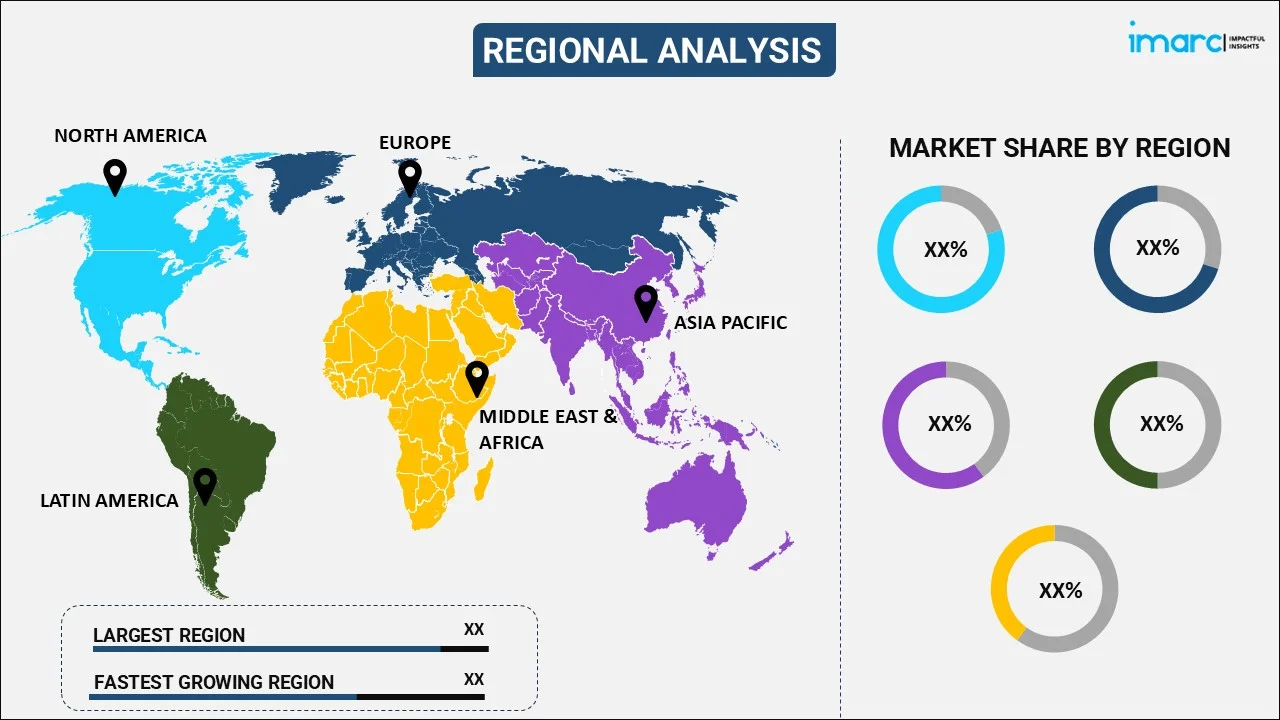
Lateral Flow Assay Market Report by Technique (Sandwich Assays, Competitive Assays, Multiplex Detection Assays), Product (Kits and Reagents, Lateral Flow Readers), Application (Clinical Testing, Veterinary Diagnostics, Food Safety and Environment Testing, Drug Development and Quality Testing), End User (Hospitals and Clinics, Diagnostic Laboratories, Home Care, Pharmaceutical and Biotechnology Companies, and Others), and Region 2025-2033
Market Overview:
The global lateral flow assay market size reached USD 10.8 Billion in 2024. Looking forward, IMARC Group expects the market to reach USD 15.7 Billion by 2033, exhibiting a growth rate (CAGR) of 4.2% during 2025-2033.
|
Report Attribute
|
Key Statistics
|
|---|---|
|
Base Year
|
2024 |
|
Forecast Years
|
2025-2033
|
|
Historical Years
|
2019-2024
|
| Market Size in 2024 | USD 10.8 Billion |
| Market Forecast in 2033 | USD 15.7 Billion |
| Market Growth Rate (2025-2033) | 4.2% |
Lateral flow assay (LFA) is a paper-based platform that detects and quantifies analytes in complex mixtures. It assists in testing biological samples of saliva, urine, sweat, serum, plasma, blood, and other fluids. As a result, it is widely employed in hospitals and clinical laboratories for the qualitative and quantitative detection of specific agents, antibodies, and gene amplification. Besides this, as it also aids in producing low-cost, simple, rapid, and portable detection devices that are utilized in biomedicine, agriculture, food, and environmental sciences, LFA is gaining immense popularity across the globe.

Lateral Flow Assay Market Trends:
Due to the coronavirus disease (COVID-19) outbreak, there is a rise in the need for an alternative of sending patient samples to the laboratory. This, in confluence with the lack of extensive laboratory facilities or trained health workers to easily conduct polymerase chain reaction (PCR) tests, represents one of the key factors bolstering the growth of the market. LFA kits are convenient, smaller, portable, and can be controlled with minimal training. They act as a one-step assay that does not require washing steps, refrigeration, and pretreatment. They also faster test procedures that offer qualitative or semi-quantitative results, take a relatively short time for development, and allow the preparation of batches in advance. Besides this, there is an increase in the prevalence of infectious diseases that require new diagnostic methods for effective treatment. This, along with the significantly rising awareness programs to enhance the spread of infections, diagnosis, and prevention, is contributing to market growth. Furthermore, leading players are introducing novel signal enhancement techniques and improving quantification systems and simultaneous detection, which is creating a favorable market outlook.
Key Market Segmentation:
IMARC Group provides an analysis of the key trends in each sub-segment of the global lateral flow assay market report, along with forecasts at the global, regional and country level from 2025-2033. Our report has categorized the market based on technique, product, application, and end user.
Breakup by Technique:

- Sandwich Assays
- Competitive Assays
- Multiplex Detection Assays
Breakup by Product:
- Kits and Reagents
- Lateral Flow Readers
- Digital/Mobile Readers
- Benchtop Readers
Breakup by Application:
- Clinical Testing
- Infectious Disease Testing
- Cardiac Marker Testing
- Pregnancy and Fertility Testing
- Cholesterol Testing/Lipid Profile
- Drug Abuse Testing
- Others
- Veterinary Diagnostics
- Food Safety and Environment Testing
- Drug Development and Quality Testing
Breakup by End User:
- Hospitals and Clinics
- Diagnostic Laboratories
- Home Care
- Pharmaceutical and Biotechnology Companies
- Others
Breakup by Region:

- North America
- United States
- Canada
- Asia-Pacific
- China
- Japan
- India
- South Korea
- Australia
- Indonesia
- Others
- Europe
- Germany
- France
- United Kingdom
- Italy
- Spain
- Russia
- Others
- Latin America
- Brazil
- Mexico
- Others
- Middle East and Africa
Competitive Landscape:
The competitive landscape of the industry has also been examined along with the profiles of the key players being Abbott Laboratories, Becton Dickinson and Company, Biomérieux SA, Bio-Rad Laboratories Inc., Danaher Corporation, F. Hoffmann-La Roche AG, Hologic Inc., Merck KGAA, Perkinelmer Inc., Qiagen N.V., Quidel Corporation, Siemens Healthineers AG (Siemens AG) and Thermo Fisher Scientific Inc.
Report Scope:
| Report Features | Details |
|---|---|
| Base Year of the Analysis | 2024 |
| Historical Period | 2019-2024 |
| Forecast Period | 2025-2033 |
| Units | Billion USD |
| Segment Coverage | Technique, Product, Application, End User, Region |
| Region Covered | Asia Pacific, Europe, North America, Latin America, Middle East and Africa |
| Countries Covered | United States, Canada, Germany, France, United Kingdom, Italy, Spain, Russia, China, Japan, India, South Korea, Australia, Indonesia, Brazil, Mexico |
| Companies Covered | Abbott Laboratories, Becton Dickinson and Company, Biomérieux SA, Bio-Rad Laboratories Inc., Danaher Corporation, F. Hoffmann-La Roche AG, Hologic Inc., Merck KGAA, Perkinelmer Inc., Qiagen N.V., Quidel Corporation, Siemens Healthineers AG (Siemens AG) and Thermo Fisher Scientific Inc. |
| Customization Scope | 10% Free Customization |
| Post-Sale Analyst Support | 10-12 Weeks |
| Delivery Format | PDF and Excel through Email (We can also provide the editable version of the report in PPT/Word format on special request) |
Key Questions Answered in This Report
The global lateral flow assay market was valued at USD 10.8 Billion in 2024.
We expect the global lateral flow assay market to exhibit a CAGR of 4.2% during 2025-2033.
The rising utilization of lateral flow assay in the field of biomedicines and environmental sciences, as it aids in producing low-cost, simple, rapid, and portable detection devices, is primarily driving the global lateral flow assay market.
The sudden outbreak of the COVID-19 pandemic has led to the growing adoption of lateral flow assay as an alternative of sending the coronavirus-infected patients’ samples to the laboratory for conducting Polymerase Chain Reaction (PCR) tests.
Based on the technique, the global lateral flow assay market has been segmented into sandwich assays, competitive assays, and multiplex detection assays, where sandwich assays currently hold the majority of the total market share.
Based on the product, the global lateral flow assay market can be divided into kits and reagents and lateral flow readers. Currently, kits and reagents exhibit a clear dominance in the market.
Based on the application, the global lateral flow assay market has been categorized into clinical testing, veterinary diagnostics, food safety and environment testing, drug development and quality testing. Among these, clinical testing accounts for the largest market share.
Based on the end user, the global lateral flow assay market can be bifurcated into hospitals and clinics, diagnostic laboratories, home care, pharmaceutical and biotechnology companies, and others. Currently, hospitals and clinics exhibit a clear dominance in the market.
On a regional level, the market has been classified into North America, Asia-Pacific, Europe, Latin America, and Middle East and Africa, where North America currently dominates the global market.
Some of the major players in the global lateral flow assay market include Abbott Laboratories, Becton Dickinson and Company, Biomérieux SA, Bio-Rad Laboratories Inc., Danaher Corporation, F. Hoffmann-La Roche AG, Hologic Inc., Merck KGAA, Perkinelmer Inc., Qiagen N.V., Quidel Corporation, Siemens Healthineers AG (Siemens AG), and Thermo Fisher Scientific Inc.
Need more help?
- Speak to our experienced analysts for insights on the current market scenarios.
- Include additional segments and countries to customize the report as per your requirement.
- Gain an unparalleled competitive advantage in your domain by understanding how to utilize the report and positively impacting your operations and revenue.
- For further assistance, please connect with our analysts.

 Inquire Before Buying
Inquire Before Buying
 Speak to an Analyst
Speak to an Analyst
 Request Brochure
Request Brochure
 Request Customization
Request Customization



.webp)




.webp)












